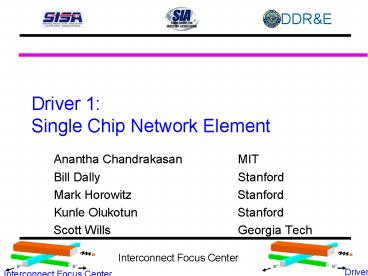Driver 1: Single Chip Network Element - PowerPoint PPT Presentation
1 / 10
Title:
Driver 1: Single Chip Network Element
Description:
Scott Wills Georgia Tech. Driver1. Interconnect Focus Center. The Bandwidth Bottleneck ... Explosion in bandwidth use will cause bandwidth bottlenecks ... – PowerPoint PPT presentation
Number of Views:20
Avg rating:3.0/5.0
Title: Driver 1: Single Chip Network Element
1
Driver 1 Single Chip Network Element
- Anantha Chandrakasan MIT
- Bill Dally Stanford
- Mark Horowitz Stanford
- Kunle Olukotun Stanford
- Scott Wills Georgia Tech
Interconnect Focus Center
e
e
e
e
2
The Bandwidth Bottleneck
- Internet traffic increasing at 2.5x per year
- Twice rate of Moores law
- 1 Tb in 2001
- 4000 Tb in 2010
- Where is the bottleneck?
- Web server
- First mile
- Backbone networks
- Last mile
Web Data Center
Router
First mile
Internet Backbone
Access
Last mile
3
Router Architecture
Routing Processor
Output Ports
Input Ports
Switching Fabric
Output Links 512 x 40 Gb
Input Links 512 x 40 Gb
- Challenges
- Power
- Redundancy
- I/O Bandwidth
4
Transaction Server
- Servers
- Web server (static, dynamic, video)
- Database server (OLTP)
- Characteristics
- Lots of threads
- Lots of sharing between threads
- Huge memory footprint
- Throughput is more important than latency
- Implications
- Throw out ILP
- Reduce use of caches
- High memory and disk BW
5
2010 Single Chip Network Element
6
Architecture Research I
- Application mapping
- discover locality in application that can be
exploited statically and dynamically - map to a modular, wire-efficient VLSI
architecture with power considerations - Network Router
- Challenge map classification, forwarding, QoS
- Must keep up with line rates (40 Tb/s)
- Network Server
- Threads naturally map to multiprocessors
- Need shared memory abstraction
- Caches vs. latency tolerance?
7
Architecture Research II
- On-chip network
- Flow control for static and dynamic traffic
- New interconnect topologies optimized for a
single chip - Processor
- Interconnect oriented architecture
- Distributed register files
- Distributed instruction issue
- Interconnect modeling and simulation
- Efficient connections to on-chip network
8
Circuits Research
- Efficient Signaling Circuits
- Increasing signal velocity with overdrive
- Reducing power with low-swing signaling
- Reducing energy with coding
- RF vs. optical vs. electrical for on-chip
networks - Clock distribution and Synchronization
- Clock networks dissipate 25-50 of chip power
- Distributing low skew clocks is challenging
- Solutions distributed clocking, active skew
management, optics
9
Optics and 3-D Semiconductor Research
- Integrated Optics required for Router application
- Reduces power
- Increases bandwidth
- 40 Gb/s link requires
- Advances in optical transmitters, receivers and
packaging - Power-efficient interface circuits
- Improve state of CMOS I/O and clock circuit
design - Gateway to on-chip networks
- Use of 3-D semiconductor Technology
- Optimize architecture for reduced wire lengths of
3-D technology - Build storage, buffers, repeaters and switches
close to layers of network interconnect
10
Conclusions
- Explosion in bandwidth use will cause bandwidth
bottlenecks - Single-chip network element with optical I/O can
break these bottlenecks - Success will require a combination of
architecture, circuits and technology research































